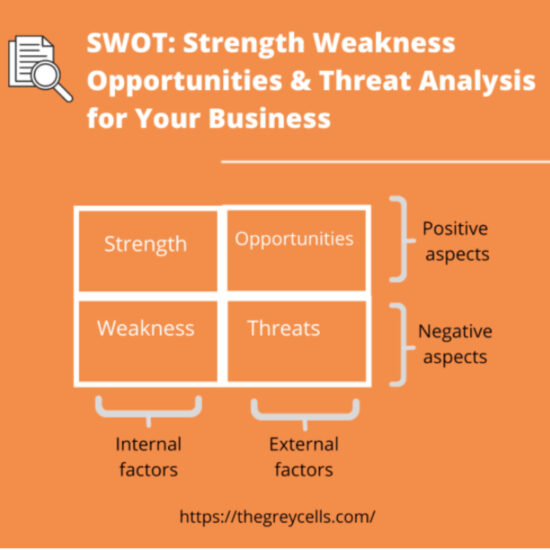SWOT: Strength Weakness Opportunities & Threat Analysis for Your Business


“You know you have a winner when your SWOT Analysis shows non-empty Weakness and Threat columns. It only means you are being true to yourself and prepared in the real sense.”
— Anu Khanchandani
Importance of business evaluation
To start a company, calculations, evaluation of the resources, team and investment analysis, market demand; all need to be looked after in order to build an impactful business outcome. In the corporate world, a bunch of different concepts exist to test out the success and growth of a business. SWOT analysis is one such popular of them.
If you aren’t undergoing any such analysis, you will be more prone to failure risk, which you could have easily avoided. This analysis gives you confidence, discover the loopholes and sort them out and prepare you to stay ahead in the business.
So, let’s look at SWOT analysis in detail.
What is SWOT analysis?
SWOT stands for Strength, Weakness, Opportunities, and Threats.
As the name itself suggests, with SWOT analysis you will be able to discover your strengths and weaknesses with respect to your business or organizations and get a good insight into opportunities and threats attached to your business.
It is found to be of great importance in all sorts of business planning; marketing, strategic planning, team development, investment, and others
Another good thing about SWOT analysis is that two of its parameters, i.e., strength and weakness are internal parameters while opportunities and threats are external. Also, strengths and opportunities are the positive factors while weaknesses and threats are the negative factors to your organization or business.
Hence, SWOT analysis gives a complete understanding of internal, external, positive, and negative aspects of you for your business, giving a holistic, and complete present scenario to start with. With SWOT analysis, you know where you stand today, and with what!
And with these analyses, you can develop a framework, plan your product, plan your marketing and keep a close eye on threats.
How to do a SWOT Analysis?
To do a SWOT analysis, get a paper or whiteboard, with your team or co-founder. In fact, I recommend recording down the discussion that you are undergoing with your team for SWOT analysis.
If you are doing it for yourself as an individual, a page or two is enough.
Let’s start with the first parameter that is strength:
Strength:
Every organization or individual has some strengths, which they must be aware of. While doing a SWOT analysis, in the first top block, write down all the strengths you or your organization has.
Do you have a strong customer base, High market demand, excellent product, motivated team, unique technology, great marketing methods; whatever it is, mention it in the SWOT analysis.
Try not to skip any strength, keep updating your SWOT analysis block as you remember more of your strength later. Because leaving out any, might make it your weakness.
Your strengths can give reasons to investors to invest in your business, give you confidence and motivation to continue your endeavor forward.
Weakness:
Weakness is the opposite of strength, and just like strength weaknesses are always there in an organization or a company.
However, our main goal by including weaknesses in SWOT analysis is to analyze those weaknesses and work on them so that they cannot be the reason for your business’s failure.
If you lack investment, have an unproductive team, underdeveloped workspace, poor facilities, etc., list down all of them in SWOT analysis, and fix their priority work on them.
Opportunities:
These are the external factors that are favorable for your business or organization. With the right strategies or action, you can grab these opportunities and benefit your business.
Mentioning your opportunities in the SWOT analysis gives you a constant reminder about them so that you don’t miss them out.
It can be small like opportunities to convert a lead into a customer, or big like any investor showing interest in your business. You must be proactive in order to entertain all these opportunities at the right time.
For example, the COVID-19 pandemic has proved to be an opportunity factor for several digital marketing companies, E-Commerce businesses, social media apps, etc.
Threats:
Threats are unfavourable external factors for your business or organisation. Unlike opportunities, they can harm your business in different ways.
But if you know what those threats are, and use your strength you can figure out solutions to those threats.
For example, if your competitor has a better product or technology, it can be a threat for your business! So, you have to figure out new interesting features for your product or new ways to do marketing to gain the attention of your competitor’s audience.
Key Takeaways
SWOT analysis is a strategy to guide your business ahead. It is a good business-meeting topic for discussion with your teammates or co-founders.
If you are aware of your strengths, weaknesses , opportunities and threats, you have conclusive traits about your business.
However, there are a few limitations of SWOT analysis. It can give you the list of all traits, external and internal factors, but does not represent the priorities on those factors.
So, along with SWOT analysis, get into other evaluations. Get real business consultations from a business coach or mentor.


















Comments are closed.